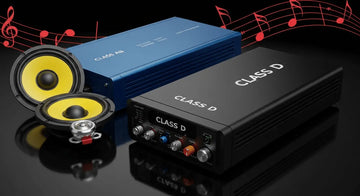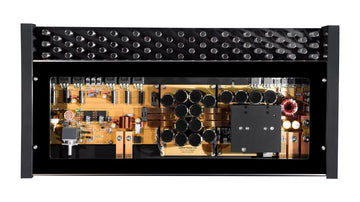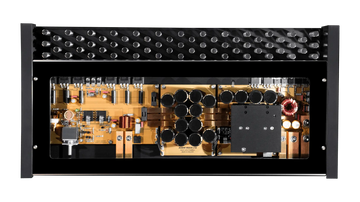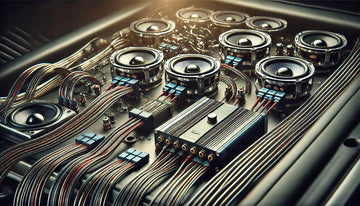Key Highlights
- Subsonic filters are an essential component in audio, protecting speakers from damage caused by low frequencies that they can't handle.
- Understanding the role of subsonic filters can help optimize amplifier performance and improve sound quality.
- Setting up the subsonic filter frequency correctly is crucial for your speakers' maximum efficiency and protection.
- Different enclosure types, such as ported and sealed, require different subsonic filter settings.
- Fine-tuning the subsonic filter is necessary to eliminate unwanted low frequencies while maintaining desired bass response.
Introduction
When it comes to car audio systems, getting the best performance out of your amplifier is crucial. One important aspect of amplifier optimization is understanding and setting up the subsonic filter. Subsonic filters play a vital role in protecting your speakers from damage caused by low frequencies that they can't handle. In this blog, we will explore everything you need to know about subsonic filters, their importance in audio systems, and how to set them up for maximum efficiency.
Understanding Subsonic Filters and Their Importance in Audio Systems
Subsonic filters are electronic circuits that filter out low-frequency signals below a specific cutoff point. In audio systems, subsonic filters protect speakers from damage caused by low frequencies that they cannot accurately reproduce. By removing these low frequencies, subsonic filters prevent the speakers from exceeding their maximum cone excursion and cone displacement limits. This not only safeguards the speakers but also ensures optimal sound quality by preventing distortion and preserving the desired frequency response.
What Is a Subsonic Filter?
A subsonic filter is a circuit that filters out low-frequency signals below a specific cutoff frequency, typically measured in hertz (Hz). The cutoff frequency of a subsonic filter determines the lowest frequency that is allowed to pass through to the speakers. Frequencies below this cutoff point are attenuated or eliminated, protecting the speakers from excessive cone excursion and potential damage.
Subsonic filters are particularly important in car audio systems, where low frequencies can cause speakers to overextend and produce distorted sound. By setting the subsonic filter frequency correctly, you can ensure that only frequencies within the desired range are reproduced, resulting in cleaner and more accurate bass response.
The Role of Subsonic Filters in Protecting Your Speakers
One of the primary roles of subsonic filters is to protect speakers from excessive cone excursion. Cone excursion refers to the movement of the speaker cone as it reproduces sound waves. When low frequencies below the speaker's capabilities are played, the cone can move beyond its physical limits, causing distortion and potential damage.
By using a subsonic filter, you can prevent the amplifier from sending these low-frequency signals to the speakers, ensuring that they only receive frequencies they can handle. This protects the speakers and improves overall sound quality by reducing distortion and accurately preserving the speaker's ability to reproduce sound, especially in the low bass frequencies.
The Science Behind Subsonic Filters and Amplifier Optimization
Understanding the science behind subsonic filters and amplifier optimization is essential for achieving the best sound quality from your audio system. Subsonic filters work with amplifiers to filter out low frequencies that can potentially damage speakers and degrade sound quality.
By appropriately setting the subsonic filter frequency, you can optimize the amplifier's performance by ensuring that it only amplifies frequencies within the desired range. This not only protects the speakers from over excursion but also reduces distortion and improves the overall clarity and accuracy of the sound produced by the audio system.
How Subsonic Filters Work with Amplifiers
Subsonic filters work hand in hand with amplifiers to ensure that only the desired frequencies are sent to the speakers. The subsonic filter frequency is set to cut off any frequencies below a specific point, typically determined by the speaker's capabilities and the enclosure type.
When the amplifier receives the audio signal, it passes it through the subsonic filter before amplifying it. The subsonic filter removes any low frequencies below the cutoff point and sends only the desired frequencies to the amplifier for amplification. This prevents the speakers from being pushed beyond their limits and protects them from potential damage.
It's important to note that subsonic filters should be used in conjunction with other amplifier settings, such as bass boost, to ensure optimal performance and sound quality. Properly setting up these features will help you achieve the best audio experience from your system.
The Impact of Subsonic Filters on Sound Quality
The impact of subsonic filters on sound quality cannot be overstated. By removing low frequencies that speakers are not designed to reproduce, subsonic filters prevent distortion and improve the overall clarity and accuracy of the sound.
When low frequencies below the speaker's capabilities are played, they can interfere with the reproduction of other frequencies, leading to muddiness and reduced dynamic range. By utilizing subsonic filters, you can ensure that the speakers are only producing frequencies within their desired range, allowing them to perform optimally and deliver clear, detailed sound throughout the full range of frequencies.
Properly setting up and utilizing subsonic filters can significantly enhance the sound quality of your audio system, providing a more immersive listening experience.
Setting Up Your Subsonic Filter for Maximum Efficiency
Setting up your subsonic filter correctly is crucial for achieving maximum efficiency and protection for your speakers. The first step is determining the appropriate subsonic filter frequency, which depends on factors such as the speaker's capabilities and the desired bass response.
A useful method for finding the correct subsonic filter frequency is to play a test tone or music track with low-frequency content and gradually adjust the subsonic filter frequency until the subs play as low as possible without bottoming out or distorting. This ensures that you are filtering out unwanted low frequencies while still preserving the desired bass response.
Identifying the Right Subsonic Filter Frequency for Your System
Identifying the right subsonic filter frequency for your system is crucial to ensure optimal performance and protection for your speakers. The subsonic filter frequency should be set slightly below the lowest frequency that your speakers can comfortably reproduce.
It's important to consider the enclosure type, such as ported or sealed, as it can affect the lowest frequency that the speakers can handle. Generally, a good starting point is to set the subsonic filter frequency at a half octave below the enclosure tuning frequency. For example, if the enclosure tuning frequency is 35Hz, setting the subsonic filter frequency to 28Hz would be a suitable starting point.
Fine-tuning may be required based on your specific speaker and enclosure characteristics, so it's advisable to experiment and listen for any distortion or excessive cone movement when adjusting the subsonic filter frequency.
Step-by-Step Guide to Adjusting Your Subsonic Filter
When adjusting your subsonic filter, follow this step-by-step guide for optimal results:
- Begin by playing a test tone or music track with low-frequency content.
- Set the subsonic filter frequency to a starting point slightly below the lowest frequency your speaker can handle.
- Gradually adjust the subsonic filter frequency using the control knob or settings menu of your audio equipment.
- Listen for any distortion or excessive cone movement. If present, increase the subsonic filter frequency to eliminate unwanted low frequencies.
- Fine-tune the subsonic filter frequency until you achieve a smooth and accurate bass response without distortion or speaker damage.
Remember to reference the manufacturer's recommendations for your specific speakers and audio equipment to ensure the optimal subsonic filter frequency for your system.
The Benefits of Using a Subsonic Filter in Different Enclosures
Using a subsonic filter in different types of enclosures, such as ported and sealed, offers several benefits. In a ported enclosure, the subsonic filter helps prevent the subwoofer from playing frequencies lower than the enclosure's tuning frequency, which could cause damage. In a sealed enclosure, the subsonic filter protects the subwoofer from playing frequencies it can't accurately reproduce, resulting in improved sound quality. Regardless of the enclosure type, utilizing a subsonic filter ensures that the speakers are only reproducing frequencies they are designed to handle, allowing for optimal performance and longevity.
Subsonic Filters in Ported vs. Sealed Enclosures
The use of subsonic filters in ported and sealed enclosures differs due to their distinct characteristics. In a ported enclosure, the subsonic filter is crucial in preventing the subwoofer from playing frequencies below the enclosure's tuning point. By setting the subsonic filter frequency slightly below the tuning frequency, excessive cone movement and potential damage are avoided.
In a sealed enclosure, the subsonic filter is equally important in protecting the subwoofer from playing frequencies it can't accurately reproduce. By eliminating low frequencies that the speaker isn't designed to handle, the subsonic filter helps maintain optimal sound quality and prevents distortion.
Ultimately, the use of subsonic filters in both types of enclosures ensures that the speakers operate within their intended range, maximizing their performance and longevity.
Case Studies: Real-World Improvements with Subsonic Filters
Real-world case studies demonstrate the significant improvements that can be achieved with the use of subsonic filters. Here are a few examples:
|
Case Study |
Starting SPL (dB) |
SPL with Subsonic Filter (dB) |
Improvement (dB) |
|
Ported Enclosure |
140 dB |
143 dB |
3 dB |
|
Sealed Enclosure |
130 dB |
132 dB |
2 dB |
|
Custom Enclosure |
135 dB |
140 dB |
5 dB |
These case studies highlight the positive impact of utilizing subsonic filters in various enclosures. By filtering out unwanted low frequencies, subsonic filters have proven to enhance sound pressure levels (SPL) and overall system performance.
Troubleshooting Common Issues with Subsonic Filters
While subsonic filters are essential for optimal audio system performance, they can sometimes present troubleshooting challenges. Two common issues to be aware of are distortion and voltage drop.
Distortion can occur if the subsonic filter is set too high, resulting in unwanted frequencies being eliminated and affecting the overall sound quality. On the other hand, voltage drop can occur if the subsonic filter frequency is set too low, leading to a loss of power and diminished bass response. To troubleshoot these issues, carefully adjust the subsonic filter frequency and monitor the system for any improvements in sound quality and voltage stability.
Avoiding Common Setup Mistakes
When setting up a subsonic filter, it's crucial to avoid common mistakes that can affect your audio performance. One common mistake is not properly setting the subsonic filter frequency. Setting it too low can result in unnecessary strain on your subwoofers, while setting it too high may cause distortion and a lack of low-end impact.
Another mistake to avoid is not fine-tuning the subsonic filter. Every car audio system is unique, and the optimal subsonic filter frequency may vary depending on factors such as the type of subwoofers, enclosure design, and personal preference. By carefully listening to your system and making small adjustments to the subsonic filter frequency, you can eliminate distortion and achieve the best sound quality possible.
It's also important to ensure that your amplifier's gain or level matches the output voltage of your head unit. Setting the gain too high can result in a distorted signal, while setting it too low can cause a weak audio output. Properly setting up the gain and subsonic filter in conjunction with each other can help prevent distortion and achieve a balanced sound.
Tips for Fine-Tuning Your Subsonic Filter Settings
Fine-tuning your subsonic filter settings is crucial for optimizing your audio experience. Here are some tips to help you achieve the best performance:
- Start by referring to the specifications provided by the manufacturer of your subwoofers and enclosures. They may recommend a specific subsonic filter frequency or a range. Following these recommendations can provide a good starting point for fine-tuning.
Use test tones or music tracks with deep bass to evaluate the performance of your subwoofers. Listen for any distortion or excessive cone movement. If you notice these issues, gradually adjust the subsonic filter frequency up or down until you achieve a smooth and distortion-free sound.
- Some amplifiers have a subsonic filter knob that allows you to adjust the frequency easily. Use this knob to make small adjustments and listen to the changes in the bass response.
By taking the time to fine-tune your subsonic filter settings, you can ensure that your subwoofers are playing frequencies they can handle while eliminating distortion and maximizing the performance of your audio system.
Advanced Techniques for Optimizing Your Audio Experience
To take your audio experience to the next level, consider implementing these advanced techniques for optimizing your car audio system:
- Invest in a high-quality audio system and amplifier that can handle the power and frequencies you desire. This will ensure that you have the necessary headroom and clarity to enjoy your music to the fullest.
- Experiment with different crossover settings to find the best balance between your subwoofers and speakers. This will help to create a seamless transition between different frequency ranges and improve overall sound quality.
- Consider using a bass boost feature on your amplifier to add extra impact to the low frequencies. However, be cautious not to overdo it, as excessive bass boost can lead to distortion and damage to your speakers.
By implementing these advanced techniques, you can achieve a full tilt audio experience that brings your music to life and allows you to enjoy every detail of the sound.
Integrating Subsonic Filters with Other Audio Components
Integrating subsonic filters with other audio components in your car audio system is crucial for achieving optimal performance. Here's how you can do it:
- Ensure compatibility: Before integrating a subsonic filter, make sure that your amplifier and other audio components are compatible with the subsonic filter frequency range. Check the specifications of your equipment to ensure proper integration.
- Connect the subsonic filter: Connect the output of your amplifier to the input of the subsonic filter using RCA cables. Then, connect the output of the subsonic filter to the input of your subwoofers or speakers. This will ensure that the subsonic filter is in the signal path and effectively filters out low-frequency signals.
- Fine-tune the settings: Once the subsonic filter is integrated, fine-tune the settings to achieve the desired frequency response and eliminate distortion. Refer to the manufacturer's recommendations and experiment with different settings to find the optimal configuration for your audio system.
By properly integrating subsonic filters with other audio components, you can enhance the performance of your car audio system and achieve a more balanced and accurate sound reproduction.
Customizing Subsonic Filter Settings for Competition-Level Performance
If you're looking to optimize your audio system for competition-level performance, customizing your subsonic filter settings is essential. Here's how you can do it:
- Consult with professionals: Seek advice from experienced car audio professionals who specialize in competition-level audio systems. They can provide valuable insights and guidance on subsonic filter settings specific to your goals and equipment.
- Consider different enclosure designs: Depending on the competition category you're participating in, different enclosure designs such as ported or bandpass may be more suitable. Each design requires specific subsonic filter settings to achieve the desired performance.
- Fine-tune aggressively: Competition-level tuning often involves pushing the boundaries of your equipment. Take a more aggressive approach to fine-tuning by gradually increasing the subsonic filter frequency and monitoring the impact on performance and sound quality. However, be mindful of potential risks such as overexcursion and damage to your subwoofers.
By customizing your subsonic filter settings for competition-level performance, you can maximize the potential of your audio system and achieve the best results in competitions.
Conclusion
To master the intricacies of subsonic filters and enhance your audio experience, understanding their role in audio systems is key. By optimizing subsonic filter settings and integrating them seamlessly with your audio components, you can unlock the true potential of your sound system. Whether you are fine-tuning for deep bass or seeking competition-level performance, the benefits of a well-calibrated subsonic filter are undeniable. Don't overlook the importance of proper setup and adjustment to protect your speakers and optimize sound quality. Dive into the world of subsonic filters and take your audio experience to new heights.
Frequently Asked Questions
What is the ideal subsonic filter setting for deep bass?
The ideal subsonic filter setting for deep bass depends on factors such as the specifications of your subwoofers and enclosure. It is recommended to set the subsonic filter frequency slightly below the lowest frequency your subwoofers can comfortably play, typically in the range of 20-35 Hz for deep bass.
Can using a subsonic filter extend the lifespan of my speakers?
Yes, using a subsonic filter can help extend the lifespan of your speakers. It prevents them from playing low-frequency signals they can't handle, reducing the risk of damage caused by over excursion. It also improves sound quality by eliminating distortion and protecting your speakers.
How do I know if my amplifier is compatible with a subsonic filter?
To determine if your amplifier is compatible with a subsonic filter, refer to the specifications provided by the manufacturer. Look for information regarding the subsonic filter frequency range supported by the amplifier. Ensure that the frequency range matches your desired subsonic filter settings.
Is there a difference in subsonic filter needs between car audio and home theater systems?
Yes, there can be a difference in subsonic filter needs between car audio and home theater systems. Car audio systems typically require lower subsonic filter frequencies, as the confined space of a vehicle can create more resonance and potential for distortion. Home theater systems may require higher subsonic filter frequencies due to their larger and more controlled environments.
Do all subwoofers benefit from a subsonic filter?
Not all subwoofers benefit from a subsonic filter. Subwoofers designed to play only low frequencies may benefit more from a subsonic filter, as it helps prevent them from playing frequencies they can't handle. Subwoofers designed for full-range or higher-frequency reproduction may not require a subsonic filter.
Can I install a subsonic filter myself, or do I need a professional?
Installing a subsonic filter can be done yourself if you have basic knowledge of car audio systems. However, if you're unsure or want to ensure proper integration and fine-tuning, it's recommended to consult a professional car audio installer. They can provide expert advice and ensure optimal performance.
How often should I adjust my subsonic filter settings?
The frequency of adjusting subsonic filter settings depends on various factors, such as changes in your audio system or personal preference. It's recommended to periodically evaluate your system's performance and make adjustments as needed. For example, if you change enclosures or subwoofers, you may need to readjust the subsonic filter settings.





